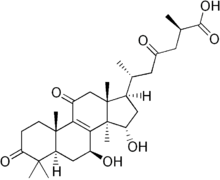Ganoderic acid
 | |
| Names | |
|---|---|
| IUPAC names
(2R,6R)-6-[(5R,7S,10S,13R,14R,15S,17R) -7,15-dihydroxy-4,4,10,13,14-pentamethyl-3, 11-dioxo-2,5,6,7,12,15,16,17 -octahydro-1H-cyclopenta[a]phenanthren-17-yl] -2-methyl-4-oxoheptanoic acid | |
| Identifiers | |
| 81907-62-2 | |
| 3D model (Jmol) | Interactive image |
| ChemSpider | 413668 |
| PubChem | 471002 |
| |
| |
| Properties | |
| C30H44O7 | |
| Molar mass | 516.67 |
| Except where otherwise noted, data are given for materials in their standard state (at 25 °C [77 °F], 100 kPa). | |
| | |
| Infobox references | |
Ganoderic acids are a class of closely related triterpenoids (derivatives from lanosterol) found in Ganoderma mushrooms. For thousands of years, the fruiting bodies of Ganoderma fungi have been used in traditional medicines in East Asia.[1][2] Consequently, there have been efforts to identify the chemical constituents that may be responsible for the putative pharmacological effects. There are dozens of ganoderic acids that have been isolated and characterized, of which ganoderic acid A and ganoderic acid B are the most well characterized. Some ganoderic acids have been found to possess biological activities including hepatoprotection, anti-tumor effects,[3] and 5-alpha reductase inhibition.[4]
References
- ↑ "Bitter triterpenoids from the fungus Ganoderma applanatum". Phytochemistry. Volume 28, Issue 1, 1989: Pages 193–197. doi:10.1016/0031-9422(89)85036-8.
- ↑ Mizuno, T.; Wang, G.; Zhang, J.; Kawagishi, H.; Nishitoba, T.; Li, J. (1995). "Reishi, Ganoderma lucidum and Ganoderma tsugae: Bioactive substances and medicinal effects". Food Reviews International. 11: 151–166. doi:10.1080/87559129509541025.

- ↑ Wang, G.; Zhao, J.; Liu, J.; Huang, Y.; Zhong, J. J.; Tang, W. (2007). "Enhancement of IL-2 and IFN-γ expression and NK cells activity involved in the anti-tumor effect of ganoderic acid Me in vivo" (PDF). International Immunopharmacology. 7 (6): 864–870. doi:10.1016/j.intimp.2007.02.006. PMID 17466920.

- ↑ Liu, J.; Kurashiki, K.; Shimizu, K.; Kondo, R. (December 2006). "Structure–activity relationship for inhibition of 5α-reductase by triterpenoids isolated from Ganoderma lucidum" (PDF). Bioorganic & Medicinal Chemistry. 14 (24): 8654–8660. doi:10.1016/j.bmc.2006.08.018. PMID 16962782.

This article is issued from Wikipedia - version of the 6/29/2016. The text is available under the Creative Commons Attribution/Share Alike but additional terms may apply for the media files.